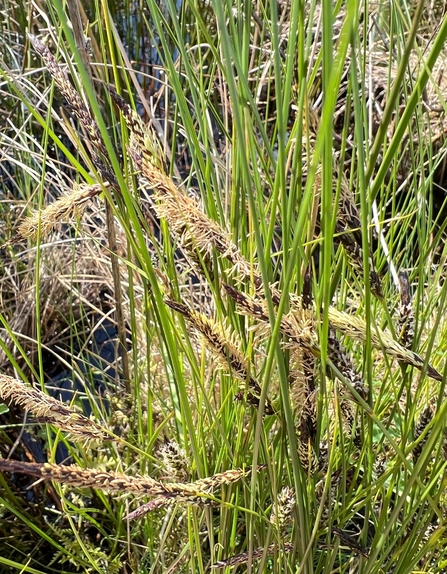Ecologists were astounded in April to come across a sudden and exuberant display of the slender sedge plant population. The species was thought lost from Askham Bog in 1930, and was rediscovered in 2021 by Alastair Fitter, Emeritus Professor of Ecology at the University of York and one of Yorkshire Wildlife Trust’s trustees, and identified by Dr Kevin Walker and Mike Porter of the Botanical Society of Britain and Ireland. A single flowerhead was found in 2023 but because this species is known to be a shy flowerer, this lack of flowers wasn’t questioned – until now.
Sedges are grass-like plants and many of them thrive in wetlands – slender sedge often grows in the water itself. As sedges are wind-pollinated, their flowers lack showy petals to attract insects and are green or brown and bunched together into ‘spikes’.
Slender sedge is still quite widespread in the hills of northern and western Britain, but most lowland populations have been lost as a result of drainage. Its rediscovery in 2021 brought the number of known sedges at Askham Bog to an amazing 22 species – a third of all British sedge species.
Alastair Fitter says, “The rediscovery of a large population of this sedge at Askham Bog suggests that it has survived for nearly 100 years without being noticed by the large numbers of regularly-visiting scientists, probably because it has not flowered.
“The likely trigger for this mass flowering is the very wet winter we’ve just had, and the part of the Bog where slender sedge grows still has standing water in early May, when normally the water level would be below the surface. This confirms other evidence that over the last hundred years the Bog has become much drier.
“If we can bring the water level back up to where it used to be – it is a Bog! - that would benefit other lost species such as crested buckler fern, last seen over a hundred years ago and now extinct in Yorkshire, and help restore the Bog to its former glory.”
Askham Bog is Yorkshire Wildlife Trust’s founding reserve, a remnant of wetland that once covered the Vale of York after the last ice age ended some 17000 years ago. Its plants and animals are exceptionally diverse, with well over 5% of all British species still recorded there – a huge number for its size, making it very unusual and very special.
Yorkshire Wildlife Trust has been working hard to make the Bog wetter for many years and some species thought lost from the site, such as the descriptively-named sedges bladder sedge, star sedge, hop sedge and remote sedge, have all been recorded in the last 10 years after many years of absence.
Questions still remain about whether these other sedges survived similarly as small unobserved populations, or if they re-colonised the site from buried seed. However, this mass-flowering of slender sedge suggests that there may be other ‘lost’ species still present but overlooked at Askham Bog.
Alastair concludes, “Despite many years of study and visits here, Askham Bog continues to surprise me. Who knows what we might find – and what might appear unexpectedly from the depths of the bog – if Askham Bog is given a chance to recover?”

